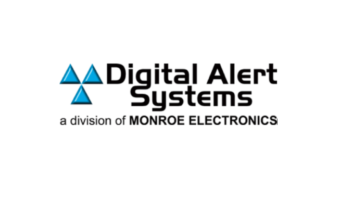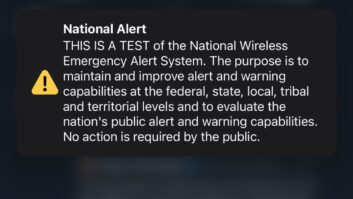
What are the lessons to learn when it comes to EAS? The Federal Communications invited individuals from various emergency communications organizations to an EAS roundtable in May to talk about ways to improve the nation’s emergency alert system.
Radio World is reaching out to individuals who participated in this EAS roundtable, including Holly Crawford, director of the San Diego County Office of Emergency Services.
Radio World: What is your position at the San Diego County Office of Emergency Services, and what are your primary duties there?
Holly Crawford: I am the director of the county’s Office of Emergency Services and lead a team responsible for alerting and notifying appropriate agencies when disaster strikes; coordinating all agencies that respond; ensuring resources are available and mobilized in times of disaster; developing plans and procedures for response to and recovery from disasters; and developing and providing preparedness materials for the public.
OES staffs the Operational Area Emergency Operations Center (a central facility which provides regional coordinated emergency response) and also acts as staff to the Unified Disaster Council (UDC), a joint powers agreement between all 18 incorporated cities and the County of San Diego. The UDC provides for coordination of plans and programs countywide to ensure protection of life and property.
Radio World: What specifically was the focus of your discussion during the FCC EAS roundtable?
Crawford: I conveyed what I see as “best practices” for local governments in the use of Wireless Emergency Alerts (WEA) and I offered suggested improvements to the WEA system that would require action from federal agencies like FEMA and the FCC.
As more people get rid of their landline phones and become less inclined to participate in “opt-in” mass notification systems, I believe WEA is the future of public alert and warning. As such, it’s important for local governments to invest in training, drills and personnel who can determine how to best use the system in their region. Our oncoming staff duty officer trains weekly in use of the WEA/EAS system and a “live” alert is not sent out without authorization from me or the assistant director of Emergency Services.
[Read: FCC: We Need More Input on WEA Multimedia]
An increase in characters and more refined geo-targeting are much-needed improvements that will be rolled out in 2019 but there are additional WEA system improvements that I urge the federal government and wireless carriers to consider.
For example, implementing multimedia capabilities into WEA messaging has the potential to save lives. When multiple fires are burning in my county, I would like to send out an image of the fire perimeters so that residents can see where they are in relation to the fires — replacing our attempt to describe multiple fire boundaries through text, which is nearly impossible with the current 90-character WEA limitation.
Radio World: Did you learn anything at this roundtable that you think might be useful to implement in San Diego county in the future?
Crawford: I learned that many state and local governments share similar challenges and grapple with similar issues as it relates to WEA. Overalerting is a concern when the current system cannot be targeted to the appropriate population. Coordination with other local governments, as well as state and federal agencies, is a real challenge during fast-moving disaster situations. The sharing of best practices is useful.
Radio World: What are the emergency issues that San Diego has to be aware of — anything particularly unique to your area?
Crawford: Our county is roughly the size of the state of Connecticut. There are few situations where the entire county population of 3+ million people will be directly impacted by one emergency. We must have tools to provide protective action recommendations in a surgical manner to the people who need to be notified.
Our disasters are “no notice” events, meaning we don’t have days in advance to take action as we await its arrival, as with hurricanes. Fires, earthquakes and tsunamis come with little advance warning and so we have to plan with that in mind.
Radio World: San Diego County had to send a WEA alert in December 2017 in light of a threatening fire. Can you share a brief overview of what happened? How well did the WEA system work for you in that instance? Did you use EAS?
Crawford: We deployed our first WEA message in December 2017 due to the Lilac Fire because the fire was destroying homes — and lives were in danger. While the alert was unintentionally broadcast to residents in neighboring counties and overalerting was a definite reality, the message served as a “bell ringer” notification that people should pay attention to conditions in their area because of the fast moving fire.
During that period, unprecedented fire conditions (low humidity, high wind and high temperatures) were prevalent throughout Southern California. While there were, tragically, serious injuries to a couple of residents and many deaths of horses, fortunately no individuals died in the fire. We consider our initial deployment of WEA a success.
Radio World: What has San Diego County learned from that episode that you might apply for future tests and alerts?
Crawford: In the future we will closely monitor the capacity of the secondary platform where people are sent for additional information. For example, our WEA message directed people to call 211 for more information. While this “saved” 911 from being overwhelmed, we want to make sure if we refer people to 211 or to a website that those platforms have increased capacity to handle the traffic surge.
Radio World: Why do you feel that FCC EAS Roundtables like these are important for the industry?
Crawford: It’s always prudent to learn lessons from other communities about how and when WEA/EAS is used — and the policies and procedures in place to ensure appropriate use of the systems.
Public alert and warning is a complex field with lots of nuance and the sharing of best practices is beneficial. I also think it is critical for the FCC and FEMA, who govern the WEA system, to hear regularly from those of us who use and deploy the technology. It’s my hope our feedback will result in rule changes that maximize the capabilities of the system while improving public safety.












